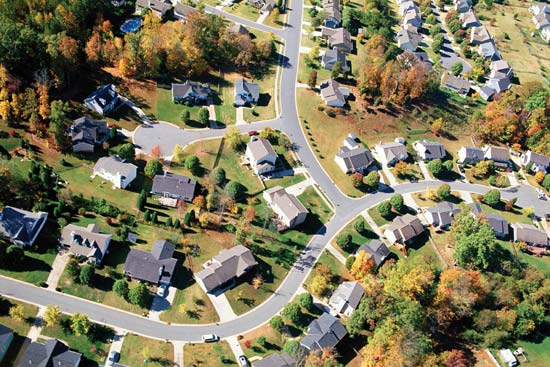Urban sprawl
Contents |
[edit] Introduction
The term 'urban sprawl' refers to the spreading of a town or city and its suburbs over previously undeveloped land. It is sometimes used interchangeably with the word 'urbanisation', but urban sprawl more precisely implies an uncontrolled, unplanned or unrestricted spreading, typically driven by migration from high-density urban areas to low-density suburban areas.
In general terms, the pattern of urban sprawl tends to be:
- During urbanisation, city centres experience higher density, with a rapid decline in periphery settlement.
- As economic growth continues, people with some wealth (typically the middle classes) begin to migrate towards the suburbs.
The phenomena is associated with a number of social and environmental consequences, and so it is often a highly-politicised, resulting in a number of competing theories as to what constitutes sprawl. While some urbanists measure the quantity of sprawl by the average number of residential units per acre, others focus on decentralisation, segregation of uses, and so on.
Generally, urban sprawl is viewed negatively, with frequent calls for it to be managed more effectively.
[edit] Characteristics of urban sprawl
The following characteristics are often associated with urban sprawl:
- Single-use development: Land is dominated by a single use and is segregated by open space, infrastructure, and so on.
- Job sprawl: Patterns of employment spread out from the central business district (CBD) to the suburban periphery.
- Low-density: Single family, low rise homes on large plots of land, spaced further apart with landscaping, roads, and so on.
- Agricultural land converted to urban use: Fertile agricultural land surrounding cities is developed.
- Housing subdivisions: Large areas of entirely of new-build developments, often characterised by curved roads and cul-de-sacs.
- Lawns: Cheaper land at the periphery often results in the proliferation of suburban lawns, country clubs and golf courses.
- Retail parks: Collections of commercial buildings (i.e. shopping centres) aimed at attracting consumers.
[edit] Causes of urban sprawl
Urban sprawl can be caused by a number of factors, often differing according to the country or region that is affected. However, some general causes can include:
- Lower land rates: Outer suburbs of cities are affordable compared to city centres.
- Improved infrastructure: Increased expenditure on infrastructure that connects the peripheries to the centre.
- Rise in living standards: Increases in average incomes allow people to afford to commute longer distances.
- Lack of urban planning: Congestion, loss of trees and green space, inadequate infrastructure, and so on.
- Lower local tax rates: City centres often have high local tax rates compared to the periphery.
- Population growth: Cities grow beyond their capacity due to a rise in population.
- Lifestyle choices: Those with higher levels of wealth choose to move somewhere with more space and lower density.
[edit] Consequences of urban sprawl
Urban sprawl tends to attract criticism and opposition, particularly from environmental groups who see it in terms of land and habitat loss, and a reduction in biodiversity.
The Garden city movement of the early-20th century provided some opposition to the trend, and new provisions were introduced in the Town and Country Planning Act 1947, such as the incorporation of green belts around urban centres.
Some of the typical consequences that give rise to urban sprawl opposition include:
- Public expenditure increase: Infrastructure and building developments often financed with public money.
- Traffic increase: With single-use developments being spaced apart, and further from the urban centre, people tend to rely more heavily on cars.
- Environmental issues: Flooding can be caused by replacing greenfield land with impervious surfaces; increased temperature from urban heat islands; loss of habitats and biodiversity.
- Social issues: Urban sprawl can lead to the homogeneity of an area as people of the same income/social group, ethnicity, age, etc., move to the suburbs. One such trend is ‘white flight’, whereby white people moved out of city centres to the suburbs, leaving poorer black communities in the centres.
See also: The compact sustainable city.
NB The term ‘conurbation’ refers to a region comprising a number of cities, large towns and other urban areas that have merged together to form one continuous urban, industrially-developed area.
Spatial development glossary, European Conference of Ministers responsible for Spatial/Regional Planning (CEMAT), Territory and landscape, No 2, published by Council of Europe Publishing in 2007, states: ‘Urban sprawl is the unplanned, uncontrolled spreading of urban development into areas adjoining the edge of a city. The term is also used to designate the expansive, rapid and sometimes reckless growth of a greater metropolitan area over a large area. Urban sprawl is characterised by several land-use patterns such as single-use zoning (commercial, residential, industrial), car-depending communities, low-density land-use but larger scale of development than older established areas (wider roads, larger stores with expansive parking lots) and lack of diversity in design, sometimes creating a sense of uniform urban environment.’
[edit] Related articles on Designing Buildings
Surrey Hills Directory
[edit] Planning
Building Design in the Surrey Hills
[edit] Highways
Conserving and Enhancing Country Lanes in the Surrey Hills AONB
[edit] Biodiversity & Landscape
Landscapes Review: National Parks & AONBs 2019
Light Pollution - Threat to Migrating Birds
Making Local Nature Recovery Strategies deliver
[edit] Health & Wellbeing
Nature and Wellbeing: The Evidence
How nature can be used to improve wellbeing







